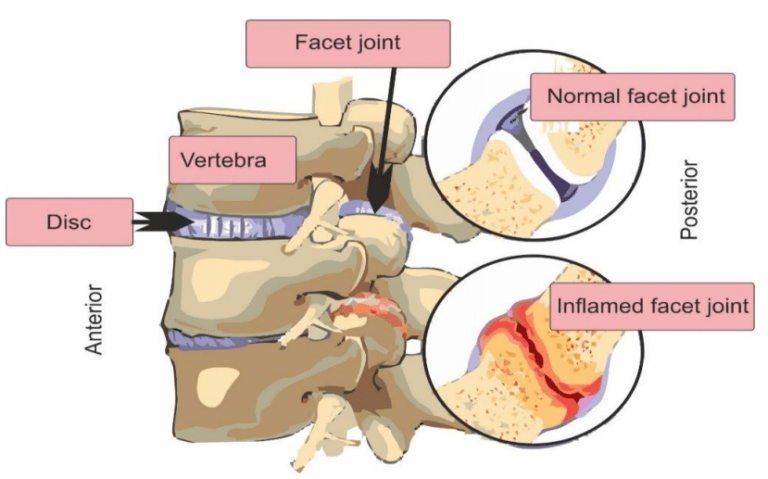Lower back pain (LBP) is relatively common among adults. As per some studies, approximately half of all adults may have some kind of back pain during the year. In about one-fifth of adults, lower back pain is chronic. According to various estimates, 15-45% of all lower back pains are facet joint pains. Since there could be so many causes of back pains, identifying the cause may be challenging [1].

Some of the most common causes of LBP are strains and sprain, degeneration of spinal joints, and inflammatory diseases like ankylosing spondylitis. Facet joint pain belongs to degenerative diseases. It is osteoarthritis of the lower back. Wear and tear in the facet joint of the spine causes local inflammation, muscle spasm, and irritation of nearby nerves. Thus, pain often radiates to the lower legs in most people.
Knowing about facet joints
To understand the source of the pain, one needs to know a bit about facet joints. The human back is a column of a vertebra. Thirty-three vertebral bones constitute the neck, thoracic spine, and lumbar spine (lower back). These vertebral bones are joined with each other with the help of two kinds of joints. A joint with large disc-like cartilage between each vertebral bone can bear the body’s weight and act as a cushion while moving – this is not a facet joint.
A facet joint is toward the posterior (outer side of the spine) or more superficial (see Figure 1). It is a joint that has the primary role of allowing the spine to bend to a degree—this joint glides and slides with the moving of the back. Unlike the intervertebral disc, it does not bear the body’s weight but controls the spine’s range of motion. The facet joint is a synovial joint. Thus, it has a capsule and is filled with fluid.
Facet joint pain
It is a pain that emerges from a facet joint. Usually, degenerative changes in the joint result in local inflammation. It is a wear and tear disease and thus more common among middle-aged and older adults. It can be compared to osteoarthritis of the knee. A condition that makes movement difficult, and pain increases while moving.
As the condition gets worse, inflammation may spread to the surrounding soft tissues. As a result, it causes spasms of surrounding muscles, further limiting the range of motion. Additionally, it may also irritate the sensory nerve of these joints, a medial branch of the sensory nerve. Irritation of this sensory nerve explains why the pain radiates in many cases (see Figure 2) [1].
In facet joint pain, the condition is made worse by physical exertion, prolonged standing, and sitting. Since there is inflammation, resting would not relieve pain. However, one would feel that the pain is higher in specific postures and reduced in others. Usually, leaning backward would increase stress on the joint and thus causing tremendous pain. On the other hand, leaning forward would relieve the pressure on the facet joint, thus bringing some relief [2, 3].
Diagnosis of facet joint pain
One can diagnose the condition based on the symptoms. Location of the pain, made worse by standing in specific postures and relieved on bending forward, may indicate the condition. Since there is local inflammation, pain may occur on applying pressure at specific parts of the spine. However, the disease is best diagnosed by a qualified medical professional, as there are numerous causes of LBP.
Generally, a doctor would ask for imaging using an x-ray or MRI. However, MRI is preferred these days as it is more sensitive. As in the early stages of spinal diseases, changes are not visible in the x-ray.
A doctor would also carry out lab tests to exclude other conditions like rheumatoid arthritis, axial spondylitis, and so on.
Unlike other causes of back pain, doctors often use the so-called facet joint injection to confirm the diagnosis. It is a procedure in which corticosteroids or anesthetics are injected into the facet joint. This would provide significant relief within 20-30 minutes. Such a kind of quick pain relief will not occur in other common inflammatory back conditions.
Treatment options for facet joint pain
In most back pains, and not just in facet joint pain, a person may benefit significantly by altering the lifestyle, improving posture, reducing stress on the spine. It may mean changing the way a person sits, altering sleeping habits. In addition, losing body weight can help as it is a disease of wear and tear.
In most back pains, physical therapy may help. Generally, a specialist would advise on certain types of exercises. Stretching exercises may help relieve pain. Strengthening of back muscles may help prevent future episodes of pain.
In milder painful episodes, one may use over-the-counter pain killers. For example, ibuprofen would generally be more effective than acetaminophen. In more severe cases, doctors would prescribe non-steroidal anti-inflammatory drugs along with muscle relaxants.
In facet joint pain, intra-articular injection of steroids is highly effective. It may provide quick pain relief that may last for days and even for years in many cases. In addition, this procedure can be repeated if needed [4].
The condition is chronic and causes severe pain and disability, in many painkillers may not help adequately. Therefore, doctors may recommend a nerve block in such people. Generally, doctors would first block a nerve with an anesthetic injection. Then, if it results in pain relief, they would permanently block that nerve using radiofrequency ablation [3].
In a small number of cases, more widespread inflammation may persist, causing nerve root compression. If no relief occurs from other treatments, the surgical correction might be an option.
Source Link : Facet Joint Pain
